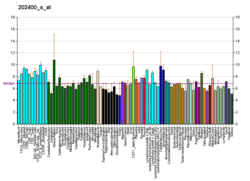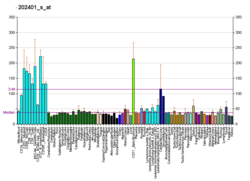혈청 반응 인자
혈청 반응 인자(Serum Response Factor, SRF)는 전사인자 단백질이다.[5]
기능
편집혈청 반응 인자는 전사인자의 MADS(MCM1, Agamous, Deficiens, SRF) 박스 수퍼 패밀리의 구성원이다.[6] 이 단백질은 표적 유전자의 촉진유전자 영역에서 혈청 반응 요소(SRE)에 결합한다. 이 단백질은 많은 초기 유전자, 예를 들어 c-fos의 활성을 조절하여 세포 주기 조절, 세포 자살, 세포 성장 및 세포 분화에 참여한다. 이 유전자는 많은 경로의 다운 스트림 대상이다. 예를 들어 삼원 복소 인자(TCF)를 통해 작용하는 미토겐 활성화 단백질 인산화효소 경로(MAPK)이다.[7][8]
SRF는 중배엽 형성과 관련이 있기 때문에 배아 발달 과정에서 중요하다.[9][10] 완전히 발달된 포유류에서 SRF는 골격근의 성장에 중요하다.[11] 스테로이드 호르몬 수용체와 같은 다른 단백질과의 SRF 상호작용은 스테로이드에 의한 근육 성장 조절에 기여할 수 있다.[12] SRF와 심근이나 Elk-1과 같은 다른 단백질과의 상호작용은 혈관 민무늬근의 성장에 중요한 유전자의 표현을 강화하거나 억제할 수 있다.
임상적 의의
편집같이 보기
편집각주
편집- ↑ 가 나 다 GRCh38: Ensembl release 89: ENSG00000112658 - 앙상블, May 2017
- ↑ 가 나 다 GRCm38: Ensembl release 89: ENSMUSG00000015605 - 앙상블, May 2017
- ↑ “Human PubMed Reference:”. 《National Center for Biotechnology Information, U.S. National Library of Medicine》.
- ↑ “Mouse PubMed Reference:”. 《National Center for Biotechnology Information, U.S. National Library of Medicine》.
- ↑ “Isolation and properties of cDNA clones encoding SRF, a transcription factor that binds to the c-fos serum response element”. 《Cell》 55 (6): 989–1003. December 1988. doi:10.1016/0092-8674(88)90244-9. PMID 3203386.
- ↑ “The MADS-box family of transcription factors”. 《Eur. J. Biochem.》 229 (1): 1–13. April 1995. doi:10.1111/j.1432-1033.1995.0001l.x. PMID 7744019.
- ↑ “Isolation and characterization of SRF accessory proteins”. 《Philos. Trans. R. Soc. Lond. B Biol. Sci.》 340 (1293): 325–32. June 1993. doi:10.1098/rstb.1993.0074. PMID 8103935.
- ↑ “SRF serum response factor”. 《Entrez Gene》. National Center for Biotechnology Information, National Institutes of Health.
- ↑ “Combinatorial expression of GATA4, Nkx2-5, and serum response factor directs early cardiac gene activity”. 《J. Biol. Chem.》 277 (28): 25775–82. July 2002. doi:10.1074/jbc.M203122200. PMID 11983708.
- ↑ “Serum response factor, an enriched cardiac mesoderm obligatory factor, is a downstream gene target for Tbx genes”. 《J. Biol. Chem.》 280 (12): 11816–28. March 2005. doi:10.1074/jbc.M412408200. PMID 15591049.
- ↑ “Requirement for serum response factor for skeletal muscle growth and maturation revealed by tissue-specific gene deletion in mice”. 《Proc. Natl. Acad. Sci. U.S.A.》 102 (4): 1082–7. January 2005. doi:10.1073/pnas.0409103102. PMC 545866. PMID 15647354.
- ↑ “Recruitment of the androgen receptor via serum response factor facilitates expression of a myogenic gene”. 《J. Biol. Chem.》 280 (9): 7786–92. March 2005. doi:10.1074/jbc.M413992200. PMID 15623502.
- ↑ “Loss of serum response factor in keratinocytes results in hyperproliferative skin disease in mice”. 《J. Clin. Invest.》 119 (4): 899–910. April 2009. doi:10.1172/JCI37771. PMC 2662566. PMID 19307725.






